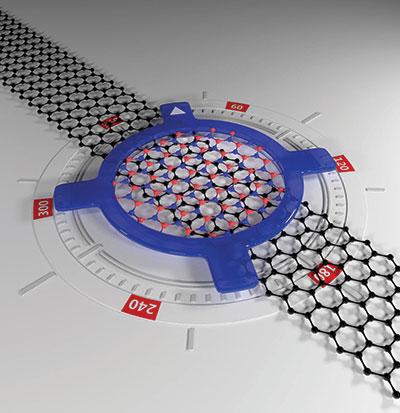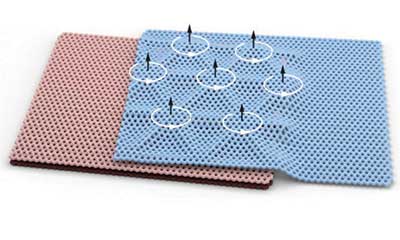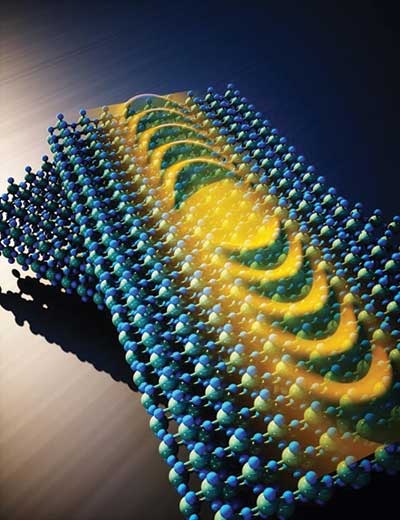Graphene and other two-dimensional materials can be given a host of exciting new properties, including superconductivity and magnetism, as Jon Evans discovers.
Graphene really is the gift that keeps on giving. This single atom-thick layer of carbon atoms arranged in a honeycomb pattern was already known to be the flattest and strongest material in existence, and to conduct electricity better than many metals.
But it now turns out that graphene can also behave like a superconductor – able to conduct electricity perfectly without any resistance whatsoever. And, rather than requiring complex chemical modifications, all it takes is a simple twist.
One sheet of graphene placed on top of another – such that the top sheet’s honeycomb pattern is misaligned with the bottom sheet by 1.1° – forms a superlattice with a new pattern. This alters the electrical properties of the two graphene sheets, turning a conductor into an insulator.
This was first shown a couple of years ago by a team of researchers led by Pablo Jarillo-Herrero at the Massachusetts Institute of Technology (MIT) in Cambridge, US. They placed one sheet of graphene on top of another such that the top sheet’s honeycomb pattern of carbon atoms was slightly misaligned with the bottom sheet, by just 1.1°. Misaligned like that, the carbon atoms in the two sheets formed a superlattice with a new pattern, known as a Moiré pattern, which altered the electrical properties of the two graphene sheets, turning them from a conductor into an insulator (Nature, 2018, 556, 80).
What was really astonishing, however, was what happened when the researchers injected electrons into the superlattice, because at a certain electron density, the graphene sheets switched from an insulator to a superconductor (Nature, 2018, 556, 43). But this only happened when the sheets were misaligned by exactly 1.1°. At angles slightly above or below 1.1°, where the sheets formed different Moiré patterns, Jarillo-Herrero and his team saw no change in their electrical properties.
Although the discovery of superconductivity was a surprise, the fact that interesting effects might arise when two graphene sheets were twisted by 1.1° had been predicted back in 2011 by a team led by physicist Allan MacDonald at the University of Texas in Austin, US. MacDonald and his team termed this the ‘magic angle’.
It took seven years to confirm this ‘magic’ prediction because of the practical difficulties of aligning two graphene sheets at exactly 1.1°. Jarillo-Herrero and his team accomplished this feat by tearing a single graphene sheet in two, twisting one half by 1.1° and then placing it on top of the other half. Soon, other researchers were trying the same thing, first to confirm the existence of superconductivity at the magic angle, and then to find out more about this astonishing new property of graphene and how it arises. What they first discovered is quite how difficult it is to produce the magic angle with precision, because graphene layers don’t really like to be misaligned.
‘There is a bit of an art to trying to make the graphene device at the magic angle of 1.1°,’ says Cory Dean, professor of physics at Columbia University in New York, US. ‘It’s very close to a 0° alignment, where the system would actually prefer to be, as it’s more energetically stable.’ While graphene layers can be twisted at angles between 5° and 30° with a fine degree of control, it becomes much more difficult at angles below 5°, explains Dean, because the layers are under strain and want to rotate away.
There is a bit of an art to trying to make the graphene device at the magic angle of 1.1°. It’s very close to a 0°alignment, where the system would actually prefer to be, as it’s more energetically stable.
Cory Dean professor of physics, Columbia University, New York, US

Jarillo-Herrero is still using his original method, although an updated version. ‘Essentially we still use that method,’ he says, ‘although the “tearing” is now done by laser cutting, so it is more precise and less disordered.’
Image caption: Dean twist device – An illustration of the approach developed by Cory Dean and his colleagues for twisting layers of graphene and other 2D materials
Once they had mastered the art of producing magic-angle graphene, researchers next tried to extend it beyond two sheets of graphene. They experimented with other two-dimensional materials, consisting of a single layer of atoms or molecules, like boron nitride and transition metal dichalcogenides. They also experimented with more than two layers of 2D materials, such as twisted bilayers of graphene, making four layers in total. They even came up with a natty name for this new field: twistronics.
In many cases, they found that twisting the layers changed their electronic properties. For example, using their novel twisting approach, Dean and his colleagues found that graphene turns into a semiconductor when placed on top of a layer of boron nitride, which is an insulator, at a 0° angle, but reverts to being a conductor at any other twist angles.
So far, superconductivity has primarily been seen in twisted layers of graphene, although researchers have discovered that the magic angle might not actually be so magic after all. Or, at least, there might be more than one magic angle. In 2019, a team led by Jeanie Lau at Ohio State University in Columbus, US, reported observing superconductivity in graphene layers twisted by just 0.93° (Science Advances, 2019, 5, eaaw9770). Meanwhile, Dean and his colleagues reported superconductivity in graphene layers at twist angles of 1.27°, but only if they also applied pressure of over 10,000 atmospheres to force the sheets closer together (Science, 2019, 363, 1059).
‘It turns out that if you move away from the magic angle and apply pressure, what that does is modulate the strength of the superlattice,’ explains Dean. ‘If we apply pressure, we change how strongly interacting the layers are, and we can shift the magic angle from 1.1° to some other angle.’
This finding supports the idea that interactions between the layers of the superlattice and the electrons in those layers may be the key to explaining the appearance of superconductivity. Such electron interactions also underpinned MacDonald’s original prediction. This is particularly interesting because similar interactions are thought to be responsible for the superconductivity in so-called high-temperature superconductors.
Graphene turns into a semiconductor when placed on top of a layer of boron nitride, which is an insulator, at a 0° angle, but reverts to a conductor at any other ‘twist’ angles.
All superconductivity is thought to be caused by interactions between electrons, specifically electrons coming together to form what are known as Cooper pairs, which can pass through materials without any loss of energy. Ordinarily, electrons don’t form Cooper pairs because they are negatively charged and so stay as far away from each other as possible. But when certain metals and alloys are cooled to a few degrees above absolute zero, quasiparticles known as phonons, caused by oscillations in the metals’ crystal lattice, mediate the formation of Cooper pairs. This is conventional superconductivity.
In the 1980s, scientists discovered so-called high-temperature superconductors such as cuprates, which exhibit superconductivity at much higher temperatures, around 100K (-173°C). This raised the possibility of developing materials that can superconduct at room temperatures, which could lead to highly efficient electricity transmission and a whole host of advanced technologies. But it has been stymied by the fact that scientists still don’t understand what causes the electrons in these materials to overcome their repulsion and form Cooper pairs, because it’s not phonons at these higher temperatures.
Magic-angle graphene might offer a clue, because phonons don’t appear to be mediating the electron interactions here either, even though the superconductivity in magic-angle graphene only appears at temperatures of a few degrees above absolute zero. Rather, the evidence suggests that the superlattice formed by the twisted graphene sheets is somehow causing the electrons to lose their kinetic energy, essentially slowing them down enough so they can start interacting.
Although electrons are repulsive, they are usually travelling too fast for this repulsion to have any effect on their behaviour. But in magic-angle graphene, the superlattice slows them down enough that this repulsion, known as Coulomb energy, starts to become dominant.
‘The reason why that’s important is that when the Coulomb energy is dominant, these electrons begin to behave largely determined by how strongly interacting they are,’ explains Dean, ‘and whenever that happens, exotic new physics, such as superconductivity, almost invariably emerges.’
That’s the basic explanation, but there’s still much scientists don’t understand about the superconductivity of magic-angle graphene. As with cuprates, this includes how repulsive interactions between electrons can act to bind them together into Cooper pairs. ‘There are a lot of theory proposals, but there is still no agreement,’ says Jarillo-Herrero.
There’s even the possibility that the superconductivity in magic-angle graphene might arise by a completely novel mechanism. ‘There’s an emerging view that the superconductivity might be different to both conventional superconductivity and high-temperature superconductivity,’ says Dean. ‘There’s a lot of experimental data coming out, and in some cases it’s pointing to one scenario and in some cases it’s pointing to another scenario.’

In the study, Dean and his colleagues placed a single layer of graphene on top of a bilayer of graphene, producing a system comprising three sheets in total. When they twisted the single layer by 1°, they found the system became magnetic. Other research groups had detected magnetism in systems that comprised a twisted bilayer of graphene on a layer of boron nitride, but this is the first time magnetism has been detected in an all-carbon system.
Like the superconductivity, this magnetism is rather unusual. Magnetism is mainly caused by the alignment of electron spins, but the spins of the electrons in carbon are not aligned, which is why it is not normally magnetic. Instead, the magnetism here appears to be solely generated by the circular motion of the electrons in the superlattice, similar to the way an electric current in a wire generates a magnetic field. This is known as orbital magnetism.
Image caption: Dean magnetic research illustration, top right, shows how the circular movement of electrons in the graphene superlattice generates magnetism.

‘Originally, we were surprised that we could translate the ideas of twistronics from the field of electron conduction to photons, as it is not trivial to draw the connection,’ said Alù. He thinks this control of the transmission of light could potentially prove of use in quantum optics, optical computing and nanoscale imaging.
Alù research illustration, right, shows how twisted layers of molybdenum trioxide can focus light into a narrow beam
At the moment, scientists are mainly busy exploring the fundamentals of twistronics and how it works, especially as magic-angle graphene offers a handy way to investigate unconventional forms of superconductivity. Whereas cuprates and other high-temperature superconductors are complex materials that are hard to model, magic-angle graphene is a much simpler system.
‘It’s a platform we can use to study a wide range of physics in a way that is more accessible than has conventionally be possible,’ says Dean. ‘We could use this platform to better understand high-temperature superconductors so we can work out how to engineer them to work at even higher temperatures.’
But scientists are also beginning to think about practical applications for twistronics, although this would require finding a way to get the superconductivity and other interesting effects to appear at much higher temperatures. One possibility is that it could lead to more efficient computing technology: magic-angle graphene systems that can switch between insulating and conducting states with a simple twist, to represent digital zeros and ones, could replace the transistors that form the basis of current computers.
In a field this young, however, more twists are undoubtedly still to come.
Image credit: Columbia University - ASRC - Philip Krantz/Krantz NanoArt





